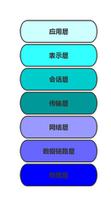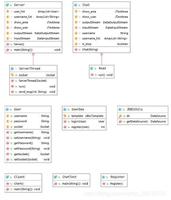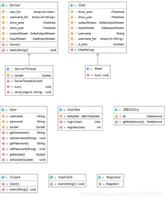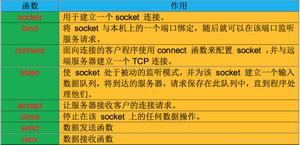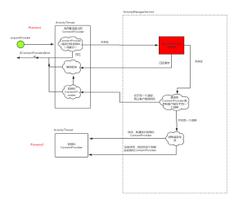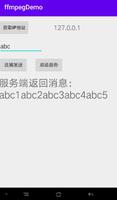Java基于socket实现的客户端和服务端通信功能完整实例
本文实例讲述了Java基于socket实现的客户端和服务端通信功能。分享给大家供大家参考,具体如下:
以下代码参考马士兵的聊天项目,先运行ChatServer.java实现端口监听,然后再运行ChatClient.java
客户端实例
ChatClient.java
package socketDemo;
import java.awt.*;
import java.awt.event.*;
import java.io.*;
import java.net.*;
public class ChatClient extends Frame {
Socket s = null;
DataOutputStream dos = null;
DataInputStream dis = null;
private boolean bConnected = false;
TextField tfTxt = new TextField();
TextArea taContent = new TextArea();
Thread tRecv = new Thread(new RecvThread());
public static void main(String[] args) {
new ChatClient().launchFrame();
}
public void launchFrame() {
setLocation(400, 300);
this.setSize(300, 300);
add(tfTxt, BorderLayout.SOUTH);
add(taContent, BorderLayout.NORTH);
pack();
this.addWindowListener(new WindowAdapter() {
@Override
public void windowClosing(WindowEvent arg0) {
disconnect();
System.exit(0);
}
});
tfTxt.addActionListener(new TFListener());
setVisible(true);
connect();
tRecv.start();
}
public void connect() {
try {
s = new Socket("localhost", 8888);
dos = new DataOutputStream(s.getOutputStream());
dis = new DataInputStream(s.getInputStream());
System.out.println("connected!");
bConnected = true;
} catch (UnknownHostException e) {
e.printStackTrace();
} catch (IOException e) {
e.printStackTrace();
}
}
public void disconnect() {
try {
dos.close();
dis.close();
s.close();
} catch (IOException e) {
e.printStackTrace();
}
/*
* try { bConnected = false; tRecv.join(); } catch(InterruptedException
* e) { e.printStackTrace(); } finally { try { dos.close(); dis.close();
* s.close(); } catch (IOException e) { e.printStackTrace(); } }
*/
}
private class TFListener implements ActionListener {
public void actionPerformed(ActionEvent e) {
String str = tfTxt.getText().trim();
// taContent.setText(str);
tfTxt.setText("");
try {
// System.out.println(s);
dos.writeUTF(str);
dos.flush();
// dos.close();
} catch (IOException e1) {
e1.printStackTrace();
}
}
}
private class RecvThread implements Runnable {
public void run() {
try {
while (bConnected) {
String str = dis.readUTF();
// System.out.println(str);
taContent.setText(taContent.getText() + str + '\n');
}
} catch (SocketException e) {
System.out.println("退出了,bye!");
} catch (EOFException e) {
System.out.println("推出了,bye - bye!");
} catch (IOException e) {
e.printStackTrace();
}
}
}
}
socket服务端代码
ChatServer.java
package socketDemo;
import java.io.*;
import java.net.*;
import java.util.*;
public class ChatServer {
boolean started = false;
ServerSocket ss = null;
List<Client> clients = new ArrayList<Client>();
public static void main(String[] args) {
new ChatServer().start();
}
public void start() {
try {
ss = new ServerSocket(8888);
started = true;
} catch (BindException e) {
System.out.println("端口使用中....");
System.out.println("请关掉相关程序并重新运行服务器!");
System.exit(0);
} catch (IOException e) {
e.printStackTrace();
}
try {
while (started) {
Socket s = ss.accept();
Client c = new Client(s);
System.out.println("a client connected!");
new Thread(c).start();
clients.add(c);
// dis.close();
}
} catch (IOException e) {
e.printStackTrace();
} finally {
try {
ss.close();
} catch (IOException e) {
// TODO Auto-generated catch block
e.printStackTrace();
}
}
}
class Client implements Runnable {
private Socket s;
private DataInputStream dis = null;
private DataOutputStream dos = null;
private boolean bConnected = false;
public Client(Socket s) {
this.s = s;
try {
dis = new DataInputStream(s.getInputStream());
dos = new DataOutputStream(s.getOutputStream());
bConnected = true;
} catch (IOException e) {
e.printStackTrace();
}
}
public void send(String str) {
try {
dos.writeUTF(str);
} catch (IOException e) {
clients.remove(this);
System.out.println("对方退出了!我从List里面去掉了!");
// e.printStackTrace();
}
}
public void run() {
try {
while (bConnected) {
String str = dis.readUTF();
System.out.println(str);
for (int i = 0; i < clients.size(); i++) {
Client c = clients.get(i);
c.send(str);
// System.out.println(" a string send !");
}
/*
* for(Iterator<Client> it = clients.iterator();
* it.hasNext(); ) { Client c = it.next(); c.send(str); }
*/
/*
* Iterator<Client> it = clients.iterator();
* while(it.hasNext()) { Client c = it.next(); c.send(str);
* }
*/
}
} catch (EOFException e) {
System.out.println("Client closed!");
} catch (IOException e) {
e.printStackTrace();
} finally {
try {
if (dis != null)
dis.close();
if (dos != null)
dos.close();
if (s != null) {
s.close();
// s = null;
}
} catch (IOException e1) {
e1.printStackTrace();
}
}
}
}
}
本机测试运行结果:
关闭客户端窗口后,提示信息如下:
更多关于java相关内容感兴趣的读者可查看本站专题:《Java Socket编程技巧总结》、《Java文件与目录操作技巧汇总》、《Java数据结构与算法教程》、《Java操作DOM节点技巧总结》和《Java缓存操作技巧汇总》
希望本文所述对大家java程序设计有所帮助。
以上是 Java基于socket实现的客户端和服务端通信功能完整实例 的全部内容, 来源链接: utcz.com/z/324322.html

